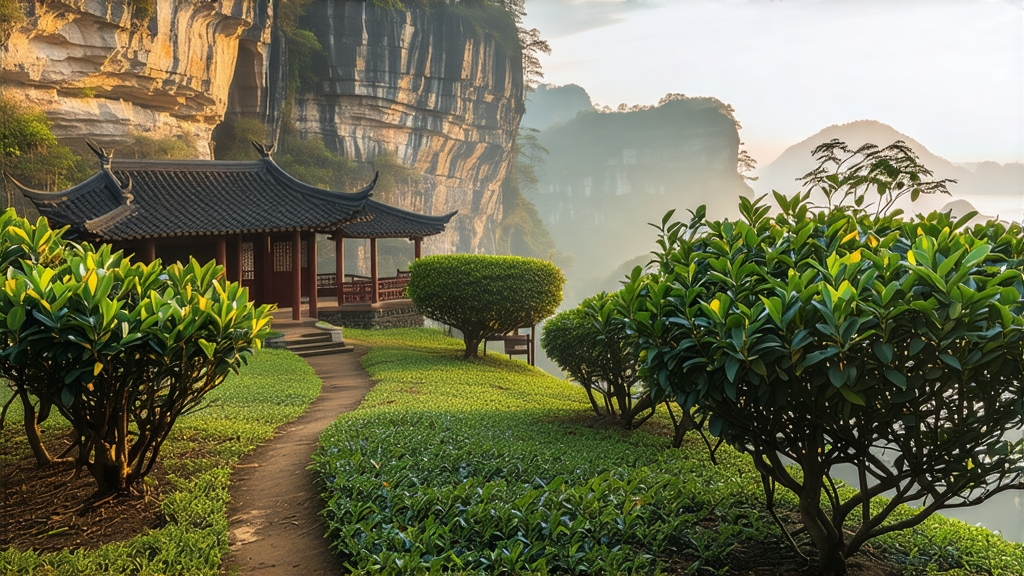
When Chinese tea lovers speak of “rock bone and floral heart,” they are invoking the spirit of Da Hong Pao, the most celebrated oolong in the Wuyi Mountains of northern Fujian. Translating literally to “Big Red Robe,” the name alone evokes imperial grandeur, yet the tea’s true majesty lies in the interplay of geology, history, and human craftsmanship that turns Camellia sinensis leaves into liquid mineral perfume.
Legend places the birth of Da Hong Pao in the Ming dynasty. A passing scholar, en route to the capital for imperial examinations, fell ill near the Tianxin Yongle temple. Monks brewed leaves picked from four stunted bushes clinging to a crack in Jiulongke, the “Nine-Dragon Cliff.” Restored to health, the scholar continued to Beijing, placed first in the exams, and returned in crimson official robes to thank the bushes. He draped his robe over them, giving both color and name to the cultivar. Whether myth or marketing, the tale cemented Da Hong Pao’s reputation as tea worthy of emperors; in 2005, 20 grams of mother-tree leaf fetched 1.56 million RMB at auction, making it the most expensive tea ever sold by weight.
Botanically, Da Hong Pao is not a single plant but a collective brand for yancha, “cliff tea,” grown within the 60-square-kilometer Wuyi World Heritage core zone. Three distinct categories exist today. Mother-tree Da Hong Pao refers to the six original bushes now retired from plucking and protected by the state; what little remains is reserved for national gifts. Pure Da Hong Pao comes from cuttings of those bushes, propagated vegetatively to preserve genetic identity; the most prized clone is the so-called “Qi Dan” lineage. Commercial Da Hong Pao, the vast majority on the market, is a skillful blend of selected Wuyi cultivars—often Qi Dan, Bei Dou, and Rou Gui—designed to recreate the mother-tree profile. Far from being inferior, these blends allow drinkers to experience the “rock rhyme” without mortgaging a house.
The Wuyi range is a 650-million-year-old rift valley whose purple-red sandstone weathers into gravelly, mineral-rich soil. Morning mist rising from the Jiuquxi, the “Nine-Bend Stream,” filters sunlight, slowing photosynthesis and concentrating amino acids. The result is a terroir-driven flavor impossible to replicate elsewhere: a licked-stone coolness the Chinese describe as yan yun, “rock charm,” layered over orchid, honey, and roasted cacao.
Crafting Da Hong Pao is a month-long choreography of wilting, bruising, oxidizing, fixing, rolling, roasting, and resting. Picking occurs in late April when three half-mature leaves and a bud form the classic “zhong kai mian” standard. The leaves are spread 3 cm thick on bamboo trays and wilted under natural shade for two hours, reducing grassy volatiles. Next comes yao qing, “shaking green,” the most labor-intensive step. In a shallow rattan tray, the tea master tosses 5 kg batches with a rhythmic wrist snap that bruises leaf edges while keeping the center intact. This partial damage allows enzymes to oxidize the rim to 30–40 %, the sweet spot between green freshness and black depth. After 6–8 repetitions across the night, the leaf aroma shifts from cut grass to ripe peach.
Oxidation is halted in 280 °C woks for three minutes—just long enough to denature enzymes without baking the leaf. Once cool, the leaves are rolled lengthwise on a heated bamboo board, breaking cell walls so oils migrate to the surface. The tight charcoal-roast that follows distinguishes Da Hong Pao from lighter southern oolongs. Using local hardwood charcoal, the tea is baked in 75 °C ovens for two hours, rested for a week, then re-baked at 85 °C; some premium lots see three cycles. The slow Maillard reactions generate pyrazines that translate into toasted walnut and dark caramel, while residual moisture drops below 3 %, ensuring decades of aging potential.
To unlock those decades in a single afternoon, gongfu brewing is essential. A 120 ml zisha teapot seasoned with only yancha seasons the clay, adding depth over years. Begin by pre-heating the vessel with just-boiled water; the purple clay will hiss softly, a sound old hands call “the first greeting